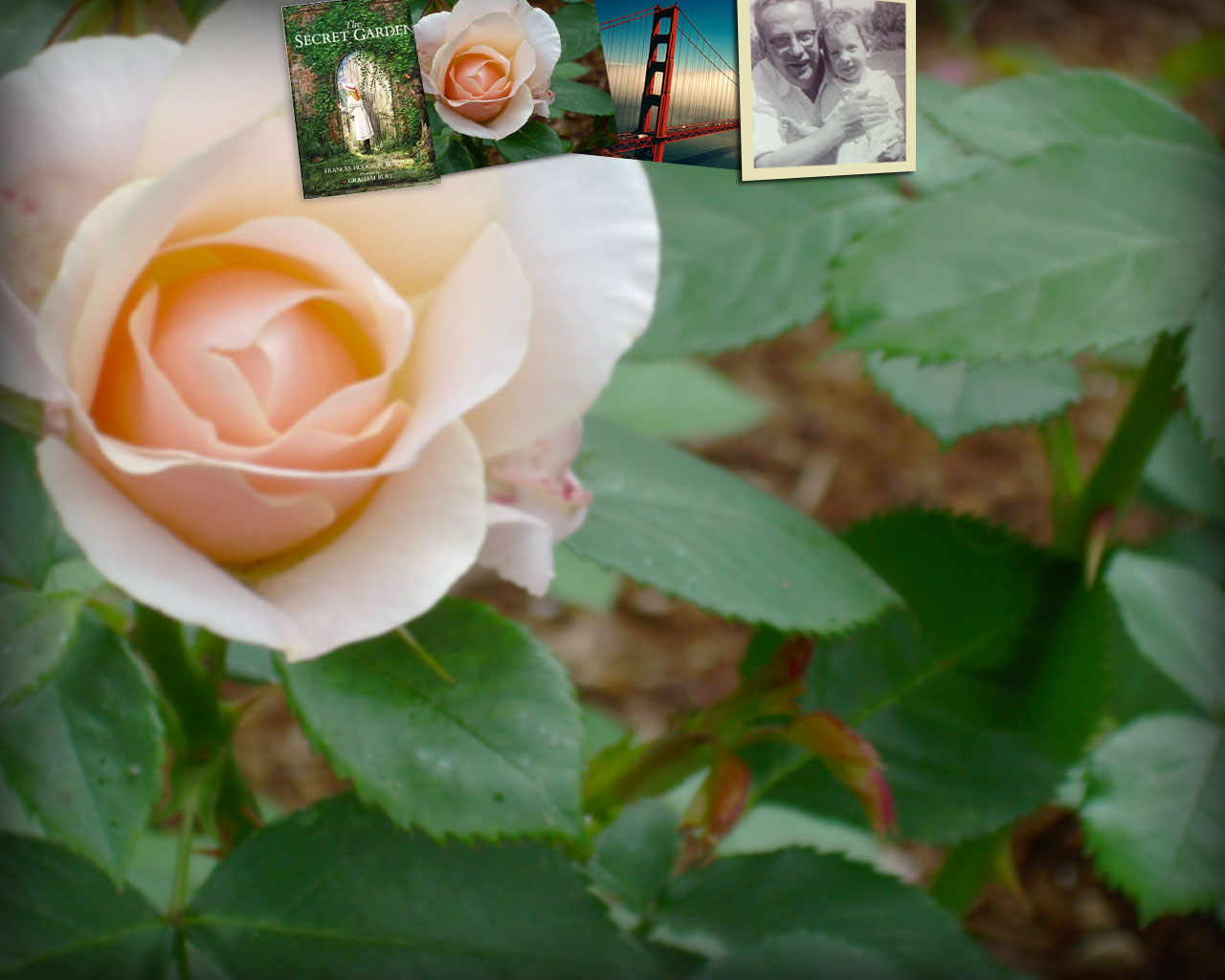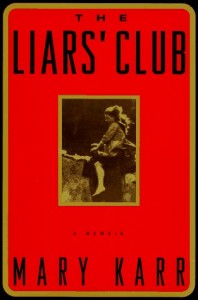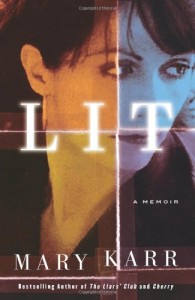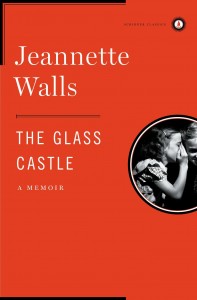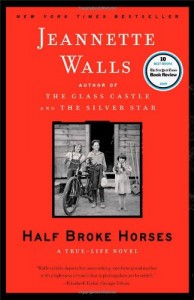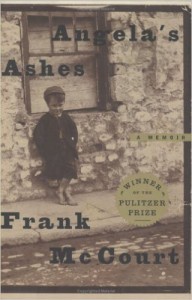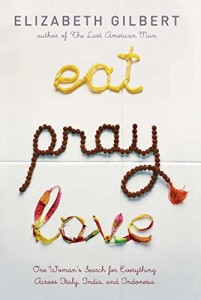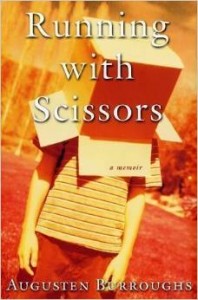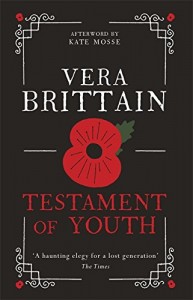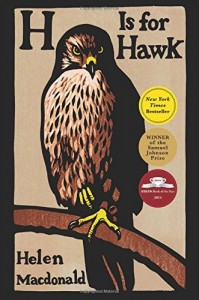Abandoned Books…
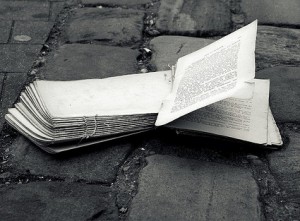 Abandoned books? I know, appalling for someone who’s barmy about books. But I admit it, I sometimes don’t finish books – even those well-reviewed best sellers thrust upon me by bookish friends or praised by other book bloggers. And it’s happening more and more often as I get older — you know the so little time, so many books theory. The 50 page rule prevails — I’ll give any book at least 50 pages before I put it down…sometimes more. This cold rejection of an author’s herculean effort always tears me apart a little bit. But, I’ve been told I’m too sensitive. So I’ll just pull up my big girl panties and give you a rundown of the books I’ve abandoned recently.
Abandoned books? I know, appalling for someone who’s barmy about books. But I admit it, I sometimes don’t finish books – even those well-reviewed best sellers thrust upon me by bookish friends or praised by other book bloggers. And it’s happening more and more often as I get older — you know the so little time, so many books theory. The 50 page rule prevails — I’ll give any book at least 50 pages before I put it down…sometimes more. This cold rejection of an author’s herculean effort always tears me apart a little bit. But, I’ve been told I’m too sensitive. So I’ll just pull up my big girl panties and give you a rundown of the books I’ve abandoned recently.
+++++++++++++++++++++++++++++++++++++++++
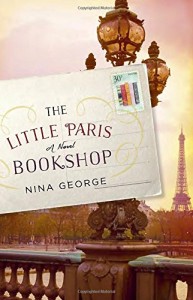 The Little Paris Bookshop: This just seemed the perfect book for me. What’s not to embrace? A bookshop on a boat — in Paris — and just look at that cover. But I found it just too whimsical and sticky-sweet. I struggled on, actually reaching chapter 28 – as the bookshop owner pilots his boat away from its long-time berth in Paris. But, just as the bookshop/boat meanders down the Seine, so too the plot – to the point where I practically fell into a sugar-laced coma.
The Little Paris Bookshop: This just seemed the perfect book for me. What’s not to embrace? A bookshop on a boat — in Paris — and just look at that cover. But I found it just too whimsical and sticky-sweet. I struggled on, actually reaching chapter 28 – as the bookshop owner pilots his boat away from its long-time berth in Paris. But, just as the bookshop/boat meanders down the Seine, so too the plot – to the point where I practically fell into a sugar-laced coma.
+++++++++++++++++++++++++++++++++++++++++++++
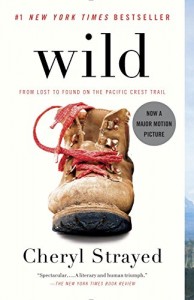 I eagerly opened Wild wanting the adventure it advertised, a broken hearted woman sets off, totally unprepared, to hike the Pacific Coast Trail. I read ten chapters into this one, but I found her grief unbelievably extreme, so raw she seemed broken beyond what a hike (or sex along the way) could solve. Her lack of emotional maturity, simply put — bored me. N.B. The author has written the complete opposite of a book, Dear Sugar which I am dipping into and so far, I’m very moved by it, so stay tuned.
I eagerly opened Wild wanting the adventure it advertised, a broken hearted woman sets off, totally unprepared, to hike the Pacific Coast Trail. I read ten chapters into this one, but I found her grief unbelievably extreme, so raw she seemed broken beyond what a hike (or sex along the way) could solve. Her lack of emotional maturity, simply put — bored me. N.B. The author has written the complete opposite of a book, Dear Sugar which I am dipping into and so far, I’m very moved by it, so stay tuned.
+++++++++++++++++++++++++++++++++++++++++++
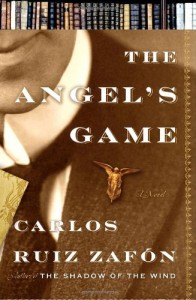 I place Carlos Ruiz Zafon’s first book The Shadow of the Wind on my list of all time favorite books. Set in a Barcelona bookstore with many secrets, I lost myself in that novel for many days. So, I had expectations that the second book in this series – The Angel’s Game – would carry on the magic. But this book is dark and very different with weird supernatural elements. I read through pages of violence and disturbing psychological ugliness. It seemed the author was angry with this writing – as he punches the reader with unresolved hard truths and unflinching observations. In the end, what made me quit reading, was the many, many characters (and some with multiple personae) — I just got plain confused. I was never sure what was going on in the convoluted story line and kept having to flip back and forth to see if I could figure out which character was which. So with a slight headache, I took an aspirin and went to bed without a backward glance.
I place Carlos Ruiz Zafon’s first book The Shadow of the Wind on my list of all time favorite books. Set in a Barcelona bookstore with many secrets, I lost myself in that novel for many days. So, I had expectations that the second book in this series – The Angel’s Game – would carry on the magic. But this book is dark and very different with weird supernatural elements. I read through pages of violence and disturbing psychological ugliness. It seemed the author was angry with this writing – as he punches the reader with unresolved hard truths and unflinching observations. In the end, what made me quit reading, was the many, many characters (and some with multiple personae) — I just got plain confused. I was never sure what was going on in the convoluted story line and kept having to flip back and forth to see if I could figure out which character was which. So with a slight headache, I took an aspirin and went to bed without a backward glance.
+++++++++++++++++++++++++++++++++++++++++++
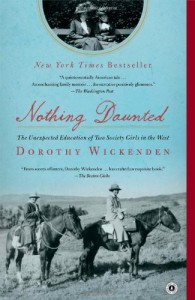 I’ve had Nothing Daunted for several years now and keep doggedly trying to get through it. Just read this blurb:
I’ve had Nothing Daunted for several years now and keep doggedly trying to get through it. Just read this blurb:
The acclaimed and captivating true story of two restless society girls who left their affluent lives to “rough it” as teachers in the wilds of Colorado in 1916.
The reviews were wonderful, I was hearing about this book everywhere. And you got to love the cover, with before and after photos of the actual subjects? The introduction is just as enticing, as the author describes coming across a folder of her mother’s forgotten letters from this adventurous time in Colorado. The author has penned an historical work, which is comprehensive, but not compelling enough to keep this reader enthralled. The landscape of the area and time period are well written. But there is no emotion written into this account and the characters are one-dimensional. The author had to obviously imagine parts of the story, why not insert some emotions as well? Sadly, as exciting as these two women’s personal experiences must have been – their story suffers from a dull and dry telling. Like ordering a beautifully described, but disappointing meal in a restaurant, I finally gave up and put it aside unfinished.
++++++++++++++++++++++++++++++++++++++++
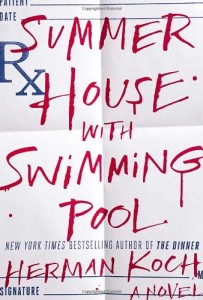 I read The Dinner by Dutch writer Herman Koch, when it was a bestseller. It’s a masterfully crafted psychological novel with the evil incident revealing itself largely by dialogue around a restaurant dinner. (Read it – it will grab you and not let you go.) So, once again I had expectations of a similar read with his second book Summer House with Swimming Pool. What happened to Mr. Koch’s writing? Where is his craft? This book, written entirely in the third person, lacked any plot as of five chapters in and the main character, whose revolting thoughts and dreary ramblings we must endure, is entirely unlikable. With The Dinner, the reader could relate and even empathize with the protective parents. This follow-up has none of that soul or depth. It is almost as if Mr. Koch dusted off one of his earlier writing attempts and the publisher ran with it.
I read The Dinner by Dutch writer Herman Koch, when it was a bestseller. It’s a masterfully crafted psychological novel with the evil incident revealing itself largely by dialogue around a restaurant dinner. (Read it – it will grab you and not let you go.) So, once again I had expectations of a similar read with his second book Summer House with Swimming Pool. What happened to Mr. Koch’s writing? Where is his craft? This book, written entirely in the third person, lacked any plot as of five chapters in and the main character, whose revolting thoughts and dreary ramblings we must endure, is entirely unlikable. With The Dinner, the reader could relate and even empathize with the protective parents. This follow-up has none of that soul or depth. It is almost as if Mr. Koch dusted off one of his earlier writing attempts and the publisher ran with it.
++++++++++++++++++++++++++++++++++++++++++++
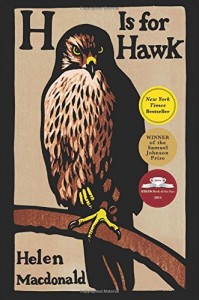 I had great hope for this glowingly reviewed memoir wherein a woman adopts and trains a Goshawk for falconry. (I had my own, albeit limited, experience helping injured hawks back to the wild — but that’s another post). Mabel, the hawk and her training is said to be a remedy for the death of her father, but that connection is never fully developed or understood. Why a mean-spirited hawk – why not a kitten or a dog? Ms. MacDonald started to loose me as she details her poor raptor’s “training” in a tiny apartment with some less than humane activities. H is for Hawk has some beautiful writing, especially when Mable’s training moves out into the open British countryside. But, I set the book aside and let it gather dust when Ms. MacDonald’s writing became tedious over her obsession with the deceased author (and even more heartless falconer) T.H. White.
I had great hope for this glowingly reviewed memoir wherein a woman adopts and trains a Goshawk for falconry. (I had my own, albeit limited, experience helping injured hawks back to the wild — but that’s another post). Mabel, the hawk and her training is said to be a remedy for the death of her father, but that connection is never fully developed or understood. Why a mean-spirited hawk – why not a kitten or a dog? Ms. MacDonald started to loose me as she details her poor raptor’s “training” in a tiny apartment with some less than humane activities. H is for Hawk has some beautiful writing, especially when Mable’s training moves out into the open British countryside. But, I set the book aside and let it gather dust when Ms. MacDonald’s writing became tedious over her obsession with the deceased author (and even more heartless falconer) T.H. White.
++++++++++++++++++++++++++++++++++++++++++++++
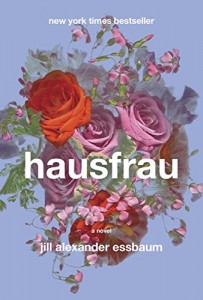 I loaded Hausfrau onto my Kindle for our trip to Switzerland, as it takes place in and around Zurich. So I settled in to read about a bored ex-pat housewife coping with a new culture as I traveled through the same country. Anna is privileged, bored and frustrated. She takes no interest in her husband or his work. Her mother-in-law cares for her house and children. Anna (even after 9 years) hasn’t bothered to learn the language or tried to assimilate. She can find no redeeming qualities in the Swiss culture or people. So naturally, she turns to meaningless sex with a series of English-speaking men. (Even the sex scenes were boring). An Anna Karenina character, but without class. That’s when I closed the book — but only after I’d mentally slapped her.
I loaded Hausfrau onto my Kindle for our trip to Switzerland, as it takes place in and around Zurich. So I settled in to read about a bored ex-pat housewife coping with a new culture as I traveled through the same country. Anna is privileged, bored and frustrated. She takes no interest in her husband or his work. Her mother-in-law cares for her house and children. Anna (even after 9 years) hasn’t bothered to learn the language or tried to assimilate. She can find no redeeming qualities in the Swiss culture or people. So naturally, she turns to meaningless sex with a series of English-speaking men. (Even the sex scenes were boring). An Anna Karenina character, but without class. That’s when I closed the book — but only after I’d mentally slapped her.
+++++++++++++++++++++++++++++++++++++++++
There you go, my pile of abandoned books, most of which were gladly donated to the library. Let them find a reader who will appreciate them and give them rave reviews.
Not to worry, I’m into some great reading with nothing abandoned for now.
What books could you not finish?
Memoirs as Salvation
~~First an apology for the radio silence. I’ve been neglecting Book Barmy lately. Last minute travel preparations dominate right now, as we prepare to leave on a grand trip next week. As a result, my reading has dwindled to a few pages at night- (sometimes the same pages from the night before) until I can’t keep my eyes open. Stay tuned for more on our travel excitement in an upcoming post. ~~
What is it about memoirs? I gravitate toward them in anxious times and decided it was because I’m a bit of a guilty voyeur combined with a dash of schadenfreude. I seem to gain solace from dipping into the disastrous lives of others. So when I came across this wonderful Mary Karr essay HERE , I knew I had a chum — another memoir lover out there.
+++++++++++++++++++++++++++++++++++++++++++++++++++++
Then there’s the infamous Angela’s Ashes by Frank McCourt. I have a fond memory of finding this book in a little bookshop in Dublin and reading it cover to cover on the flight home. During the flight, as I was hunkered into this book, the attendant brought me my meal and commented on what I was reading — I confessed I felt guilty eating because poor Frank and his family hadn’t had enough food for days.
From the opening of Mr. McCourt’s autobiography:
When I look back on my childhood I wonder how I managed to survive at all. It was, of course, a miserable childhood: the happy childhood is hardly worth your while. Worse than the ordinary miserable childhood is the miserable Irish childhood, and worse yet is the miserable Irish Catholic childhood.
++++++++++++++++++++++++++++++++++++++++++++++++
One of my all time favorites is Eat Pray Love, by Elizabeth Gilbert. Read this memoir for it’s depiction of a trip of a lifetime and Ms. Gilbert’s personal journey. Rediscovering joy, peace and love while gaining friends, insights and few extra pounds along the way. It’s really not as sappy as I just made it sound – honestly.
+++++++++++++++++++++++++++++++++++++++++++++++
And now for something similar yet completely different … Running with Scissors by Augusten Burroughs. Once again we witness a nightmarish youth and the reparations, but in this case Mr. Burroughs tells his tale in such a way that it is both entertaining and outrageous. So entertaining, in fact that some studio attempted to make a film based on the book. Just terrible, give it a miss – the film that is – not the book.
+++++++++++++++++++++++++++++++++++++++++++++++
I was recently reminded of the classic Testament of Youth – an autobiography of a independent woman who volunteers as a nurse during WWI. I missed many a wild club scene evening buried in its pages back in the 80’s. It’s been adapted into what looks to be a promising film (trailer HERE).
++++++++++++++++++++++++++++++++++++++++++++++++
The other evening I started this unique memoir. Grieving over the unexpected death of her father, Helen MacDonald rediscovers her love of falconry with a prickly and murderous goshawk — named Mabel. I’m only a few chapters in and it’s riveting (at least for as long as I’m able to stay awake these recent nights).
Not forgetting the other memoirs here on Book Barmy –THIS or THIS
What are your favorite memoirs or autobiographies?
Helene Hanff – a love affair
Thanks to Simon at Stuck in A Book, I was reminded of my long-time love affair with Helene Hanff -a lesser-known author who has achieved cult status among bibliophiles. Ms. Hanff was a hard working writer–she wrote essays, television screen plays, magazine articles and industry trade publications –most anything to pay the rent. She was also witty, intelligent and incredibly well read. She put her love of literature, London and New York City into her wonderfully captivating writing. Her books are just plain terrific, based on her own experiences — no fiction necessary here — and none will take you long to read. I believe all are well-worth a permanent place in your personal libraries.
+++++++++++++++++++++++
Ms. Hanff (and yes she would have insisted on ‘Ms’) is most famous for her book 84 Charing Cross Road, which I have read and re-read so many times I had to buy myself a new copy. 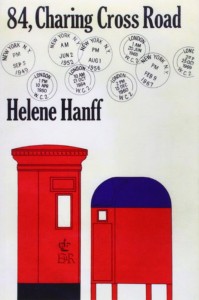 In case you don’t know of this book – it is must reading for any bibliophile. It chronicles the 20-year correspondence between Ms. Hanff and a London antique bookshop located at 84, Charing Cross Road. Ms. Hanff writes to this bookshop seeking various English literature titles in nice affordable volumes. To her delight, she receives not only affordable, but beautifully bound antique editions of her requests — “so fine they embarrass my orange-crate bookshelves”. The letters back and forth over the years are funny, warm and sometimes heartbreaking. The correspondence captures not only the shared love of literature, but family news, dental woes, wartime shortages (she sends the shop food packages during war rationing years) and finding book treasures at English estate sales. The book was made into a 1986 film which did a passable job of portraying the characters and the premise. It stars Anne Bancroft and Anthony Hopkins so you won’t be wasting your time. Remember tingle books? 84, Charing Cross is on my top 10 list.
In case you don’t know of this book – it is must reading for any bibliophile. It chronicles the 20-year correspondence between Ms. Hanff and a London antique bookshop located at 84, Charing Cross Road. Ms. Hanff writes to this bookshop seeking various English literature titles in nice affordable volumes. To her delight, she receives not only affordable, but beautifully bound antique editions of her requests — “so fine they embarrass my orange-crate bookshelves”. The letters back and forth over the years are funny, warm and sometimes heartbreaking. The correspondence captures not only the shared love of literature, but family news, dental woes, wartime shortages (she sends the shop food packages during war rationing years) and finding book treasures at English estate sales. The book was made into a 1986 film which did a passable job of portraying the characters and the premise. It stars Anne Bancroft and Anthony Hopkins so you won’t be wasting your time. Remember tingle books? 84, Charing Cross is on my top 10 list.
+++++++++++++++++++++++
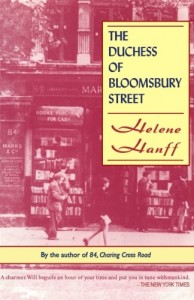 The Duchess of Bloomsbury Street chronicles Ms. Hanff’s experiences in London after the publication of 84, Charing Cross Road. She finally makes her first long overdue trip to London and meets her friends from the bookshop, as well as her fans. Taken completely by surprise, Ms. Hanff and her book are
The Duchess of Bloomsbury Street chronicles Ms. Hanff’s experiences in London after the publication of 84, Charing Cross Road. She finally makes her first long overdue trip to London and meets her friends from the bookshop, as well as her fans. Taken completely by surprise, Ms. Hanff and her book are
celebrities in London. Here she tells of this once-in-a-lifetime trip where she is treated to a whirlwind of introductions, dinners, teas, tours and finally seeing her precious London.
+++++++++++++++++++++
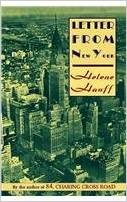 If you’re going to New York City, live there, or just love the city from afar, you need to find yourself a copy of Letter From New York.
If you’re going to New York City, live there, or just love the city from afar, you need to find yourself a copy of Letter From New York.
From the back cover: From 1978 to 1984, Hanff ( 84 Charing Cross Road ) recorded a five-minute broadcast once a month for the BBC’s Woman’s Hour about her everyday experiences as a resident of New York City.
Here you’ll meet her friends, neighbors and fellow apartment-house dwellers. She describes free concerts, out-of-the-way city parks, her favorite neighborhoods, people and dogs. This is Ms. Hanff’s New York City – sweetly old-fashioned, intimate and never pretentious.
++++++++++++++++++++++
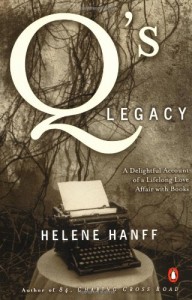 Ms. Hanff was unable to finish her college education, she simply ran out of money. So she decided to educate herself at the public library by working her way through English Literature A to Z. Q’s Legacy chronicles how she discovers Sir Arthur Quiller-Couch –the infamous Cambridge Dean of English Literature and his book “On the Art of Writing”. Reading “Q” spawns a long reading list which now includes English lit classics from Milton, Newman and Walton. Ms. Hanff is unable to find affordable or attractive copies in NYC bookstores. Then one day while reading The Sunday Review of Literature, she spots an advertisement for a bookshop in London …and so the story loops back to the genesis of 84, Charing Cross Road.
Ms. Hanff was unable to finish her college education, she simply ran out of money. So she decided to educate herself at the public library by working her way through English Literature A to Z. Q’s Legacy chronicles how she discovers Sir Arthur Quiller-Couch –the infamous Cambridge Dean of English Literature and his book “On the Art of Writing”. Reading “Q” spawns a long reading list which now includes English lit classics from Milton, Newman and Walton. Ms. Hanff is unable to find affordable or attractive copies in NYC bookstores. Then one day while reading The Sunday Review of Literature, she spots an advertisement for a bookshop in London …and so the story loops back to the genesis of 84, Charing Cross Road.
++++++++++++++++++++++
 Here’s a photo of the bookshop – Marks & Co.
Here’s a photo of the bookshop – Marks & Co.
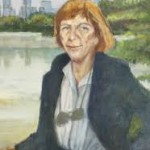 And a portrait of Ms. Hanff – her favorite.
And a portrait of Ms. Hanff – her favorite.
Ms. Hanff passed away in 1997 – poor and without any surviving relatives. Her NY Times obit HERE.
I think that somehow she must know her books are beloved, re-read and cherished by many a book lover.
French Dirt by Richard Goodman
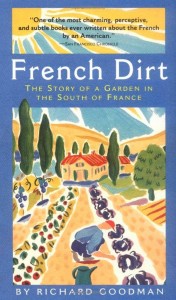 Richard Goodman saw the ad in the paper: “SOUTHERN FRANCE: Stone house in Village near Nimes/Avignon/Uzes. 4 BR, 2 baths, fireplace, books, desk, bikes. Perfect for writing, painting, exploring & experiencing la France profonde. $450 mo. plus utilities.
Richard Goodman saw the ad in the paper: “SOUTHERN FRANCE: Stone house in Village near Nimes/Avignon/Uzes. 4 BR, 2 baths, fireplace, books, desk, bikes. Perfect for writing, painting, exploring & experiencing la France profonde. $450 mo. plus utilities.
And so, with his girlfriend Iggy, he leaves New York City to spend a year renting a two hundred year old stone house in Southern France. Located in a small village fictionally called St. Sebastien de Caisson, it doesn’t have a cafe, store or even a post office. Starry-eyed, Richard and Iggy soon discover they are having a tough time connecting with the locals. Out of necessity, Richard works in a vineyard in exchange for firewood. In the vineyard, he forms a solitary friendship with Jules, a handsome 25 year old, and through that relationship Richard borrows a small plot of land. Having a difficult time making friends in his little village, Richard determines to make a vegetable garden instead.
Oh no, you say, not another “my experiences in France book” — trust me, this one is different — part travelogue, part gardener’s journal, part pilgrimage and wholly enjoyable. I read French Dirt when it was first published in the 90’s and remember it fondly. It has recently been republished with a pretty new cover (shown here) and when I picked it up in the bookstore, I remembered I still had my copy lurking in my towering chaos collection of books. I dug out my older copy (Yes, I knew right where it was – I’m a “rainman” when it comes to locating my books) and re-read French Dirt over the last two evenings.
What sets this tale apart from the plethora of “my life in France” books, is that Richard is such a hapless American on so many levels. His plans for his garden, forming friendships with the locals, and settling in to a new life often go awry. You chuckle and wince as he binge-buys plants and tries to sort out conflicting advice from the villagers — but then you cheer as he toils and worries over his garden, delights in its growth and is distraught by his garden disasters — all while the neighbors politely hide their amusement at the silly American.
It’s not all fun and games, there is quiet despair as Richard struggles to master the ancient house repairs and loneliness when they are housebound during an endless number of rainy days. But as his garden grows, slow friendships also develop. There is a heart-warming and funny description of a prank in which one of the least likely villagers secretly places perfect red, ripe tomatoes in his garden in early June.
Happily, the book does not parody the villagers — there are no caricatures of French people – they are treated gently and with respect in this memoir. And while Richard struggles and fails, he never feels sorry for himself or blames others. He is open and honest with his own shortcomings. Richard is also serious and perhaps even somber as he recounts the backbreaking hours in the brutal Southern French sun — all for a beloved garden which he knows he must abandon at the end of the year.
He writes; “I would crouch down on one knee, thrust my hand shovel in and turn the earth up and over, revealing its darker, humid underside. Then I would crumble it slowly in my hands to better allow the plant to breathe. In that sense I had a comradeship with the earth: I must be able to breathe, too.”
No question that this is a “gardener’s tale” — if you are not interested in gardens or gardening – this may not be a book for you. And admittedly, the writing is often far from perfect, but you won’t mind as Richard’s story is heartfelt and true.
French Dirt is a gentle adventure of sorts — the American as an immigrant and the searching for a new identity in an old place. If like me, you ever daydream, even just a little bit, about moving to a foreign country – this is a perfect afternoon-in-the-hammock summertime read.
The Unspeakable by Meghan Daum
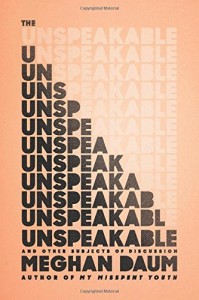 This book of essays has gained some excellent reviews … so I was excited when it was my turn for the Kindle library book.
This book of essays has gained some excellent reviews … so I was excited when it was my turn for the Kindle library book.
One reviewer said “Daum is her generation’s Joan Didion.”(Melissa Giannini). I should have clued in to “her” generation’s Joan Didion. I guess I’m in the actual Joan Didion generation – she’s one of my favorite writers. (Slouching Towards Bethlehem is brilliant.)
I also didn’t clue in to the title — “Unspeakable” — which is truly accurate — these essays are beautifully written and some of her writing spoke right to my heart, but too often her writing made me anxiously squirm in my chair — uncomfortable with her uncensored candidness — as if watching a stranger undress or the Maury Povich Show.
Ms. Daum’s subject matter ranges from a coldly sad essay on matricide with harsh observations about her mother — to the weird – playing charades with a group of Hollywood notables including Nicole Kidman.
In “Honorary Dyke” she disguises her slight homophobia as flirting with lesbianism.
The whole scene freaked me out enough to make me realize that I was not a lesbian so much as someone who appreciated a good haircut.
(I realized I was) Biologically straight, culturally lesbian.
See? Uncomfortably funny – I bet you’re hoping none of your gay friends see you giggling at this.
In “Difference Maker” Ms. Daum shares her experience of being both a big sister and a court appointed advocate for a foster child. Her unflinching look at the reality of being a foster teen will break your heart. She paints foster care, and the children within the system, in the harsh cruelty that it is. Did you know there are ‘adoption fairs’ where foster children have 5 minutes per couple to plead why they should be adopted? She nails it by calling this a barbaric form of speed dating.
Ms. Daum likes to show off her incredible vocabulary using words such as opprobrium, quotidian and hypnagogic. Click to get the definitions – I had to to.
Happily, her writing is often thoughtful and quietly disarming. For me, her writing shines when she explores aging and evolving.
How did I get to be middle-aged without actually growing up?
I had not yet figured out that life is mostly an exercise in being something other than what we used to be while remaining fundamentally — and sometimes maddeningly – who we are.
To grow up and get to know yourself is primarily an exercise in taking things off the table.
Her thoughts on women’s culture are noteworthy, as in this precise take on the media
…all the crap in the media that suggests that not only are women a special interest group, they’re a group whose primary interest is themselves.
With great beauty, Ms. Daum reveals her uncertainty about getting married (she does) and her choice to remain child free (which she is). But as I read her thoughtful angst over these major life decisions – I found her both immature and apologetic — as if seeking our approval for her choices.
Our conversations and our sleep would remain uninterrupted. Our lives would remain our own. Whether that was fundamentally sad or fundamentally exquisite, we’d probably never be sure. But who can be sure of such things? And what so great about being sure anyway?
Unspeakable can be light and funny in parts, as in when Ms. Daum talks about not having the least interest in food or the “foodie” movement.
Once or twice my husband has suggested we take a cooking class together. From my reaction, you would think he’d proposed that we volunteer to pick up trash alongside the highway.
And her secret desire to live at Downton Abbey:
More likely, I’d be dreaming of living at Downton Abbey. Flu epidemics and abysmal women’s rights aside, I often think living in a Jacobethan mansion in the early twentieth century and having my meals cooked and served by professionals would suit me just fine. That’s pretty preposterous, however. In reality it would be a nightmare. In reality I would be so intimidated by the servants and so awkward in their presence that the relief of not having to cook would be dwarfed by the pressure to make polite conversation. I’d end up taking dinner in my bedroom every night, like a grieving widow or an unseemly visiting artist.
The final essay, Diary of a Coma recounts her infection with a deadly virus and she takes us step by tedious step through her symptoms and misdiagnosis and eventually being put into a medically induced coma. Not for the queasy this, but nonetheless she contemplates her life, her judgmental tendencies, her shortsightedness and selfishness and vows to be a better person. But in the end she knows she can’t be a better person — in fact she won’t even try — she will, in the end, remain the same person. Her thoughts even as she faces death remain painfully unsentimental.
In summary, I read this collection of essays in uncomfortable but stunned disbelief – at Ms. Daum’s audacity, her often flawless writing, her shameless self-absorption — but most of all at her bravery – writing and exposing her uniquely own “unspeakable” mind.
My Life in France by Julia Child
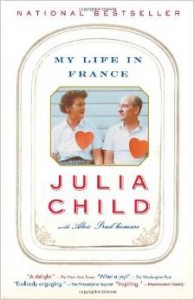 Last night, I happened upon Julie and Julia on HBO. Although I have seen the film several times, I couldn’t help watching it again. It’s a fun, but limited portrayal of Julia Child’s early years in France. The sadly departed Nora Ephron based her screenplay on two memoirs — Julie and Julia by Julie Powell and My Life in France by Julia Child.
Last night, I happened upon Julie and Julia on HBO. Although I have seen the film several times, I couldn’t help watching it again. It’s a fun, but limited portrayal of Julia Child’s early years in France. The sadly departed Nora Ephron based her screenplay on two memoirs — Julie and Julia by Julie Powell and My Life in France by Julia Child.
Skip Julie Powell’s memoir (I found it insipid) but if; 1) you adore food and travel, 2) own at least a few cookbooks (maybe one of which is Julia Child’s Mastering the Art of French Cooking), or 3) need to escape your own, perhaps routine, life for a more exciting one in post WWII France — then get your winter-weary self to your local bookstore or library and get a copy* of My Life In France. You’ll thank me later.
Julia kept notes and letters, and in the last years of her life, she began to shape this book with her grandnephew Alex Prud’homme. The result is a brilliant journey with Julia Child — to read this book is to be right with her in France — tasting the food, smelling the baking bread, walking on the French cobblestones and embracing it all with Julia’s delight and gusto. This is an engaging story of Julia’s early isolation in a foreign country that at once confused but enthralled her, and she faces these challenges with self-deprecation and charming self-confidence.
There is, of course, an abundance of French food. But there is also hard work — from her struggles with learning French to outright chauvinism at the male-dominated Corden Bleu cooking school where Julia finally gains admittance. You get a wonderful glimpse into the private lives of Julia and Paul and their remarkable marriage. She tells of “making do” in post war France, of having to initially cook on a hot plate (this will not do!), spotty electrical service and need to shop at individual markets for each meal’s provisions. There is a sober side to her memoir as she and Paul deal with an erroneous McCarthy investigation as a result of his OSS work.
Her struggles during the creation of her infamous two volume cookbook Mastering the Art of French Cooking (which shot to the best seller lists after the release of the Julie and Julia film) are fascinating as Julia painstakingly tests, re-tests and then tests again countless recipes. The perfectionism in the development of her mayonnaise recipe caused me to crack open my copy of the cookbook just to read the recipe. (I have plans to attempt it one of these days.) The differences between flour in France versus America causes great concern for an worthy cross-Atlantic baguette recipe. She tells of the early troubles with the massive two-volume Mastering the Art of French Cooking — from the many titles considered to publisher rejects and her co-authors dramas.
Julia Child embraced all these experiences – good and bad – as part of a remarkable journey and she clearly loved everyone who accompanied her along the way. This is not just a book about food, this is a book brimming with life — full of passion, wisdom and creation. One can learn a lot from such a well lived life. I hang on to my own copy of My Life In France for gloomy times and a quick dip into its chapters restores my faith in life as an exciting adventure.
